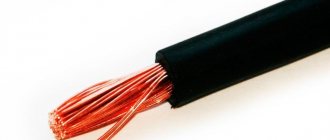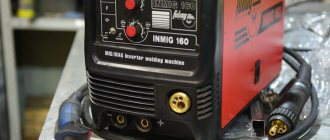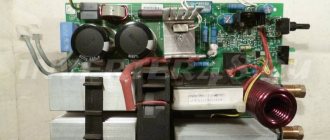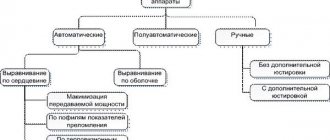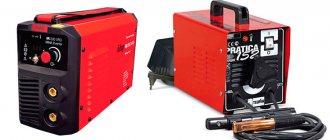Welding is an excellent way to connect parts; it occurs by melting metals using a welding arc. This type of connection is called arc welding. But to carry out the work you need to know a number of subtleties - polarity, choice of current, electrodes and, finally, the cable itself. The latter is needed to connect the welding inverter to the power source, as well as connect the ground clamp and electrode holder directly to the welder itself. In this article we will look at how to choose a cable for a welding machine, what should be the cross-section and grade of the conductor.
Welding cables for inverter - types of cables
The welding cable operates under increased load parameters: high voltage passes through it inside, and outside it is affected by temperature changes, friction force and other conditions.
Performance characteristics:
- DC current at voltages up to 1000 V or alternating current - up to 600 V.
- Frequency no more than 400 Hz.
- Operates on 220 and 380 V mains.
The stores offer an assortment of goods.
Single-core
Made of copper, so it conducts current very well. The wire is flexible and elastic. Designed for inverter devices with low power.
Twin-core
The products are made for pulsed electric welding and contain a cathode and anode. They are made from copper wire or wire from alloys containing copper.
Three-core
The label contains technical characteristics that should be taken into account when choosing a product:
- KS is a product intended for all types of work.
- P are welding wires coated with a polymer that provides additional protection. If a number is written during marking, it indicates the number of cores.
- HF is a product designed for high-frequency voltage.
Three-core welding wires - cables of this type are made for technically complex equipment. According to the technical process conditions, the seam must be perfect.
Useful article - Do you know how much an oxygen cylinder weighs and what its volume is?
Welding of fiber optic lines
Modern technology allows us to avoid signal loss when transmitting over long distances; fiber optics are used for this. The product contains translucent threads with a reflective coating, through which the high-frequency signal passes without attenuation. The optical cable is laid for communication needs for various purposes and is an noise-proof, encrypted transmission link between subscribers. There are multimode and single-mode lines that differ in signal quality and price, but provide ideal isolation between communication nodes.
When installing lines of this kind, it becomes necessary to weld the fiber optic cable, which is a complex engineering task, since the thickness of the central core is 62.3 microns. For this purpose, special welding devices are used, which minimize quality losses and consist of the following components, namely:
- video control unit with monitor;
- heat shrink device with carriage and electric drive;
- guides with optical and mechanical correction systems;
- fiber optic welding module with arc creation unit;
- processor control board with controllers;
- source of supply voltage and welding current.
Units for welding optical waveguides have autonomous, classified software and an interface that allows maintaining high confidentiality of data transmission.
Welding cable brands and their characteristics
Welding wires are subject to increased loads from equipment and environmental factors. The service life of the welding cable depends on the correct choice. The welding cable is marked with digital and letter symbols. To help you choose which cable to choose, the descriptions below are given.
Description of flexible welding cable KG
The meaning of the letters “KG” in the marking means that the cable is flexible. This is a common type of product. Operates with direct current with a voltage rating of up to 1000 V, with alternating current - not exceeding 600 V, at a frequency of not more than 400 Hz. Connects from a 220 or 380 V network or by connecting a holder and a clamp.
Cable for welding work KOG1
To manufacture the product, conductors with small cross-section diameters are used. This is useful when creating seams in inaccessible places. To prevent loops from sticking out on the sides, you can use the cable wound around your hand. This is convenient when working at heights.
Designed for operation at a voltage of 220 V and a frequency of 50 Hz.
Welding cable KGN
KGN, the letter “N” means that the wire is fireproof. The insulating layer is made of a heat-resistant compound and can withstand temperatures of more than 200 0C. This cable can be used not only for welding, but for cutting (plasma or electrode), for example, for emergency work in case of emergency situations.
The wire will not melt when it comes into contact with heated metal products.
KG HL
The product index contains the designation “HL”, that is, it can be used in frosty conditions. It contains rubber that can withstand the cold. Flexibility is maintained at temperatures down to -60 0C, making the wires ideal for northern regions. If work is carried out in open areas, then attention should be focused on this product.
Welding cable KPES
The product is intended for semi-automatic welding or is a cable for a welding inverter. This variety uses spiral tubes instead of wires. In order for the circuit to be closed and the electric arc to be excited, a wire is passed inside the cord, which can be of three types:
- whole;
- tubular;
- with flux.
The cost depends on the size of the internal diameter. If the structure is hollow, then the service life is reduced by one and a half years. The electric main supplies voltage from 42 to 48 V at direct or alternating current. At temperatures down to -10 0C, a low-voltage line is used.
Useful article - Everything you need to know about Poxypol glue to avoid welding
PIC
The insulating layer uses polyvinyl chloride. The product is resistant to abrasion and is ideal when a worker needs to constantly move, dragging the cable behind him. The core is preserved due to reliable insulation. Operates under a load of 127 or 220V, at temperatures from -40 to +400C, not flexible. Welding wires for the inverter are used to connect to the outlet.
Welding cable brand KGT
The product is designed for high temperatures. Operation of the product is possible at +850C. The product is suitable for use in humid climates.
KRPT model
This wire is flexible with cores. The veins are made of copper. The shell and insulation are made of rubber. The welding cable is manufactured by the manufacturer to work with the following parameters:
- At 660V AC and 110V DC.
- Permissible current load from 3 to 20A/mm2.
- Temperature range from -60 to +500С.
The cross-section of the welding cable depends on the number and cross-section of the cores - from 8 to 69 mm. The product is not flammable.
Signs of a quality product
You can quickly assess the quality of a cable using a number of characteristics. The main ones are the following:
- the technical specifications should indicate the effective area of the core, and not the total;
- the formation of a separate core from a larger number of wires increases both the current load capacity and improves the bending characteristics;
- the price of such a product cannot differ greatly from the market average;
- abandoning copper in favor of copper-plated aluminum is unacceptable; copper must have a good degree of purification from impurities (can be assessed by the resistance value);
- shell and/or insulation made of PVC instead of rubber significantly increases service life.
It is advisable to purchase products from leading manufacturers who pay great attention to product quality.
Cable for a welding machine - how to choose the right one
It is known how products are labeled. The main thing is to choose the right product so that it matches the parameters of the welding machine and other characteristics.
What should a vein be like?
Cable types:
Single-core.
Used to connect the inverter to the holder and ground. The 1x16 marking stands for: “1” is 1 core, not divided into several wires under one sheath. During operation, heating is reduced and voltage transfer is accelerated.
Stranded.
The 11x30 marking stands for: 11 – number of cores. They are used for industrial equipment operating under voltages of more than 500 V. The core is made of aluminum or copper. Aluminum cables are supplied with the devices; they are cheaper. They are usually purchased by beginning workers.
For professionals, it is suggested to purchase copper products, since the resistivity indicator is 7 times less than aluminum. This reduces current losses.
If the copper cable manufacturer is China, then such products are better suited for domestic use rather than for industrial needs, since they are designed for low resistance.
Cable section for welding machine
If the product cross-section is chosen incorrectly, the risk of equipment wear increases. A fire or ineffective operation may occur due to a short circuit. If the wire cross-section is not sufficient, then an increased level of current will be required for the welding mode. The holder will be more difficult to move when creating a seam vertically or on the ceiling.
The table shows the dependence of the current on the cross section.
Cable flexibility requirements
Welding wires for inverter are used in work with flexibility above class 4. Selecting heavy wires will make it more difficult for the welder to bend or wrap them.
When choosing a KG cord, which is classified as class 5 in terms of flexibility with a diameter of 0.41 mm. If the product is marked KOG, then it belongs to class 6 in terms of flexibility. Flexibility 0.21 mm - increased.
Useful article - 9 main types of welding machines used everywhere
Welding cable length
If it is necessary to move along large structures, then a long cable must be connected to the device so as not to carry the inverter. If the work is carried out in one place, then it is enough to purchase 2 m for the ground, and 3 m for the holder. For production, it is recommended to buy 5 meters of wire for the ground and for the holder.
Lengthening the product for no reason leads to a decrease in current due to an increase in resistance.
The length of the welding cable should not exceed the calculated values. The maximum current indicator must be divided by 100.
For example:
160 /100= 1,6
The result is a divisor by which you need to divide the value of the wire cross-section. That is, if the cross-section is 1x25 mm2, then
25/1.6=15 m.
The length turned out to be maximum, it needs to be divided into connections to the ground and the holder: 5 and 10 meters.
When connecting a longer product, the current output from the device will decrease. To extend an additional wire, copper crimping is used, and the cable can also be extended by welding or soldering, but twisting is prohibited. Twisted connections create an increase in resistance, so they are not allowed.
The procedure for calculating the power cross section
In general, the calculation of the cable cross-section for power occurs in 2 stages. To do this you will need the following data:
- Total power of all devices.
- Network voltage type: 220 V – single-phase, 380 V – three-phase.
- PUE 7. Rules for electrical installations. Edition 7.
- Conductor material: copper or aluminum.
- Wiring type: open or closed.
Step 1. The power consumption of electrical appliances can be found in their instructions or take the average characteristics. Formula for calculating total power:
ΣP = (P₁ + Р₂ + … + Рₙ) · Кс · Кз,
where P1, P2, etc. is the power of connected devices, Kc is the demand factor, which takes into account the probability of turning on all devices at the same time, Kz is the safety factor in case of adding new devices in the house. KS is defined as follows:
- for two simultaneously switched on devices – 1;
- for 3-4 – 0.8;
- for 5-6 – 0.75;
- for larger quantities – 0.7.
In calculating the cable load, it makes sense to take the short circuit as 1.15-1.2. For example, you can take a total power of 5 kW.
Step 2. At the second stage, it remains to determine the cross-section of the conductor based on the total power. For this purpose, a table for calculating the cable cross-section from the PUE is used. It provides information for both copper and aluminum conductors. With a power of 5 kW and a closed single-phase electrical network, a copper cable with a cross-section of 4 mm2 is suitable.
Assembling the device
The delivery set for manual arc welding includes two wires:
- for holder;
- for mass.
This is a standard set that comes with an inexpensive device. When purchasing a separate set, you should not trust the quality of budget models either. If you purchase a set at the highest price, the cost will differ little from the cost of the inverter. Therefore, it is better to assemble the device yourself.
Electric holder
This is the most important device that you should not skimp on. The quality of the work performed depends on it.
There are only three types of products:
- Spring. They are convenient for work.
- Fork. These are the most reliable, but are not easy to use and in most cases are not insulated. Made by workers.
- Screw. The electrode is fixed securely at the desired angle. The quality is excellent, the price is reasonable. Especially suitable for beginners.
The cross-section of the welding cable depends on the size of the holder.
Power cables or wires
These elements are considered to be the second most important in the design. The maximum current and arc ignition depend on the quality of the power cable. When working with an inexpensive device, this is especially true; if the device produces a current of up to 130 A, then welding seams can be confidently performed with 3 mm electrodes.
Ground clamp
There are several types of clamps:
"Crocodile". Or a clothespin.
Attached directly to the part. The connection is reliable, convenient, fastens quickly, produces minimal resistance, and opens well. Parts of different configurations are fixed. The disadvantages include the low level of strength due to the spring in the device; it is used only when the product needs to be secured. Terminal models available for sale are 300, 200 or 500 A. The choice depends on the model of the device.
Magnetic.
The clamp can be attached to any base, the design is designed for long-term use, can withstand power surges and does not burn out, is used in hard-to-reach places, and is secured securely. Non-delivery includes unreliable fastening in small areas, periodic cleaning of dirt and dust, overheating is not allowed, as demagnetization is possible.
Clamp.
These are clamps with a high degree of fastening reliability, fixed with a hex head screw, smooth current transition is ensured due to good contact. Disadvantages include the complex structure and large size of the terminals.
Cable terminal (plug)
To quickly and reliably connect the cable to the power source, you need a detachable terminal (plug). This product can be used to connect lengths of wires.
The device terminal (plug) is made of high quality copper or brass with a round profile.
The technological hole on the back side of the terminal is used to secure the cable. The cone coupling is made of rubber, so it protects well from mechanical damage. A copper sleeve is supplied with the plug. The wire is installed into the coupling, and then into the sleeve and into the brass body. Fixation is carried out with a screw, tightly tightened.
When choosing a product you need to pay attention to:
- Wire section. The most popular are cables and wires with an area of 10, 25, 30, 35, 50 and 100 mm2.
- The connection is fixed, so the chain does not break when the wires are strongly tensioned.
- The plug must match the size of the device (there are 2 main sizes: 10-25 mm and 35-50 mm)
Calculator for calculating cross-section by diameter
To simplify calculations, a calculator has been developed for calculating cable cross-section by diameter. It is based on formulas that can be used to find the cross-sectional area of single-core and stranded wires.
You need to measure the cross-section by measuring the core without insulation, otherwise nothing will work. When it comes to calculating tens and hundreds of values, an online calculator can significantly simplify the life of electricians and electrical network designers due to convenience and increased speed of calculations. It is enough to enter the value of the core diameter, and, if necessary, indicate the number of wires if the cable is multi-core, and the service will show the required wire cross-section.
Is it possible to extend the welding cable
The length of the welding cable should not exceed 3 m. It is difficult to work with such a product, especially at height. Manufacturers do not recommend increasing the length further.
What negative situations may arise:
- Sharp drop in current.
- Increase in voltage due to self-induced emf.
- The output electrodes may be punctured.
To avoid this, a choke was used on the devices. The product was installed to accumulate energy and release it to form an arc when the transistors are closed and there is no current in the primary winding. Many manufacturers do not include these devices in their products because the price of the equipment increases.
Extension of the cable is not recommended, this is due to the fact that it has reactive and active resistance. As a result, the output voltage and current drop.
If the length of the wire changes, the operation of the entire system may be disrupted and even the equipment may fail.
In practice, it has been established that an increase in length up to 5 m is acceptable if the cross-section of the welding cable matches.
Length calculation rules
Calculation of the cable cross-section along the length assumes that the owner has determined in advance how many meters of conductor will be required for the electrical wiring. This method is usually used at home. For the calculation you will need the following data:
- L – conductor length, m. For example, the value taken is 40 m.
- ρ – resistivity of the material (copper or aluminum), Ohm/mm2 m: 0.0175 for copper and 0.0281 for aluminum.
- I – rated current, A.
Step 1. Determine the rated current using the formula:
I = (P Ks) / (U cos ϕ) = 8000/220 = 36 A,
where P is the power in watts (the total of all appliances in the house, for example, the value is 8 kW), U is 220 V, Ks is the simultaneous switching factor (0.75), cos φ is 1 for household appliances. In the example, the value turned out to be 36 A.
Step 2. Determine the cross-section of the conductor. To do this you need to use formula (2):
R = ρ · L/S.
The voltage loss along the length of the conductor should be no more than 5%:
dU = 0.05 220 V = 11 V.
Voltage loss dU = I R, hence R = dU/I = 11/36 = 0.31 Ohm. Then the cross-section of the conductor must be no less than:
S = ρ · L/R = 0.0175 · 40/0.31 = 2.25 mm2.
In the case of a three-core cable, the cross-sectional area of one core should be 0.75 mm2. Hence, the diameter of one core must be at least (√S/ π) · 2 = 0.98 mm. Cable BBGng 3×1.5 satisfies this condition.
Rules for connection and use
To make a correct connection you need to know the following rules:
- To connect the welder, on one side there are connectors and tips attached to the solder of the device plug.
- Welding cables are connected to each other using crimping. Connections must be insulated.
- The connection is made to the power connectors of the device, the electrode is inserted into a holder attached to the other end of the wire. The main thing is to know the rules of polarity.
- Requirements for welding machines and cable requirements must fully comply with all technical standards, including rated power.
Basic requirements for safe operation
All devices powered by electric current are subject to increased labor protection requirements.
List of basic requirements:
- The core must have a cross-section that can withstand the load from electric current.
- The wire must withstand shock loads and negative influences from aggressive environments.
- The braiding of the welding wires for the inverter must remain elastic and resilient, despite the twisting of the wires.
- It is not allowed to pull the device by the wire.
- The welder must work in appropriate clothing and shoes with mandatory head protection.
- If special clothing and reliable protection against current are not available, then work should not be started.
Parallel connection of electrical wiring wires
There are hopeless situations when you urgently need to lay wiring, but there is no wire of the required cross-section available. In this case, if there is a wire with a smaller cross-section than necessary, then the wiring can be made from two or more wires, connecting them in parallel. The main thing is that the sum of the sections of each of them is not less than the calculated one.
For example, there are three wires with a cross-section of 2, 3 and 5 mm², but according to calculations, 10 mm² is needed. Connect them all in parallel and the wiring will handle up to 50 amps. Yes, you yourself have repeatedly seen the parallel connection of a large number of thin conductors to transmit large currents. For example, welding uses a current of up to 150 A and in order for the welder to control the electrode, a flexible wire is needed. It is made from hundreds of thin copper wires connected in parallel.
In a car, the battery is also connected to the on-board network using the same flexible stranded wire, since when starting the engine, the starter consumes current from the battery up to 100 A. And when installing and removing the battery, the wires must be taken to the side, that is, the wire must be flexible enough . The method of increasing the cross-section of an electrical wire by connecting several wires of different diameters in parallel can be used only as a last resort. When laying home electrical wiring, it is permissible to connect in parallel only wires of the same cross-section taken from the same reel.
Which one is needed for mass
The cable for ground clamping ( ground terminals ) and its cross-section must be selected in exactly the same way as a conductor for any type of welding equipment.
Quite often, both experienced and novice welders are faced with the problem of insufficient wire length . Some performers connect two complete conductors into one to clamp the mass, and for the electrode holder they buy an additional cable of the required length. In similar and other similar cases, you should know how to properly connect the cords.
several ways to do this : “twisting”, welding, soldering, crimping, using couplings. Each of the listed methods has its own advantages and disadvantages. About the pros and cons, as well as about the connection technique, see the article “Connection, connection and extension of the welding cable.”
